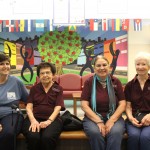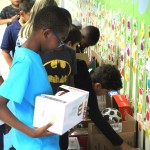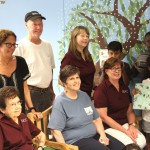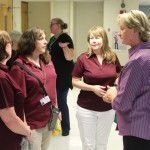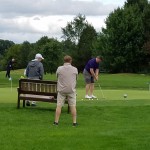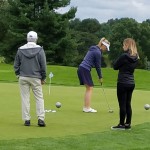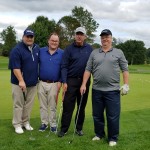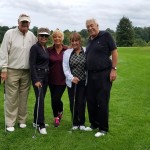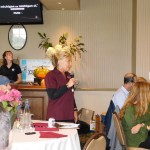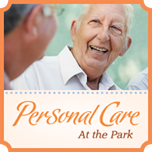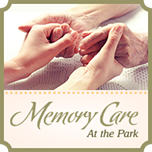The ability to communicate is a skill we’ve learned from a young age. It’s much like riding a bike or tying our shoes. However, unlike those previous examples, communication isn’t some skill that we learn once and never have to work at it again. There are numerous scenarios that require different approaches to communication in order to have a much more effective conversation, based on who our audience is. It’s no secret that you communicate differently with your friends than you do with your parents. You communicate differently with little kids than you do with older adults. It’s not a one-size fits all kind of skill.
This is also true when communicating with a loved one who has Alzheimer’s disease. Your conversation with them needs to be much more precise and on point compared to a conversation you would have with a long-term friend. In order better your communication skills when talking with someone who has Alzheimer’s disease, read the following tips below.
Limit Distractions
When talking with a loved one who has Alzheimer’s disease, it’s important to find an environment that is limited in distractions. If you’re in the living room and the TV is at full volume, it’s going to be very difficult to maintain their focus. The same goes for the radio or a stereo playing their favorite music. It’s true that music therapy is great for Alzheimer’s or dementia patients, but it’s not good to have it going on in the background when you’re trying to have a conversation with someone. Make sure that all surrounding electronic devices are off or their volume is lowered before starting your conversation.
Use Full Names
One of the worst aspects about Alzheimer’s is that your loved one may begin to forget names and faces. Your own mother or father may not recognize you when you start to talk with them. However, do not be discouraged. Instead, make sure you’re using full names. Don’t refer to yourself as their son or daughter. That might not mean anything to them. It’s also important, if you’re referring to a sibling, to use their full name, too. It’s much better to use a proper name than a word that describes one’s relationship to the person with Alzheimer’s. A proper name resonates better in the brain, especially if you’re just using pronouns like him or her.
Be Clear
If communication becomes difficult in the middle of a conversation, you might find yourself participating in “baby talk” with your loved one. It’s best to refrain from doing so. In general, it’s always good to speak clearly and in full sentences. There’s nothing wrong with trying to keep the conversation simple, but baby talk adds a level of condescension that your loved one may not appreciate. Speak slowly and clearly but not in a way that it can be insulting.
Use Nonverbal Cues
Eye contact and a smile can go a long way in any kind of conversation. It’s even more crucial when you’re talking to someone with Alzheimer’s disease. Your loved one may not understand every word coming out of your mouth, but non-verbal cues can still help when it comes to facilitating understanding. A brief hand gesture to an object they can’t quite seem to name or a simple smile can drastically change the tone of the conversation or your loved one’s mood.
Keep It Simple
Someone with Alzheimer’s disease will have a hard time keeping track of multiple subjects in one conversation. That’s why it’s a good idea to keep it simple. Keep the conversation pertaining to one subject at a time. This will make it easier for your loved one to follow along and participate in an active conversation, which is great exercise for their mind.
Be Patient
You’re going to have to realize that there will be good days and there will be bad days. Sometimes it might be difficult to get a word out of your loved one during conversation. Other days he or she may be completely active and looking to converse. When the two of you are experiencing those bad days, it’s important to practice patience. The very last thing you want to do is to have a short temper when communicating with a person who has Alzheimer’s disease. Yes, it’s frustrating to have to repeat yourself. Yes, it’s disheartening to have a loved one forget your name. However, it’s more important that you’re there for them. Your agitation will only cause them to be agitated. Keep that frustration in check and make sure your loved one is having a productive day.
Breast cancer awareness is not the only health issue that is celebrated in the month of October. October 20th marked a day of recognition regarding Osteoporosis, a bone disease that involves a lack of bone production or an overall weakening of the bones. Fortunately, this disease is largely preventable through education and some simple lifestyle changes.
What is Osteoporosis?
As stated above, it’s the weakening of your bones. However, in order to understand how this occurs, it’s important to understand the structure of your bones. If you place the material that makes up your bones under a microscope, you can see that the inner workings of it looks like a honeycomb. That are gaps and holes all throughout the inside of a bone. They’re actually porous. This allows your bones to have a little give to them, but still remain incredibly sturdy overall.
For someone who suffers from Osteoporosis, the gaps in the bones are much larger than the average person’s. This severely increases one’s chances of breaking a bone, because the structural integrity of their bones is compromised. The density is much less, leaving them with a higher chance of fractures and broken bones.
This can also occur in your vertebrae. As a result, people may lose height and their posture may become slightly bent or hunched over. This may lead to chronic pain and a lack of mobility. It’s easy to look upon Osteoporosis and think, “If I just don’t fall and stay careful, I shouldn’t have to worry about it,” and that is incorrect. This is a disease that slowly sneaks up on you and can greatly reduce your quality of life if you’re not monitoring it. Luckily, there are ways to prevent it or even reverse it.
Lifestyle Changes
There are medications that you can take to help reduce the rate at which your bone’s lose their mass and density. However, there are also lifestyle changes you can make in order to reverse the effects of Osteoporosis without having to take prescribed medicine. They are:
Exercise
It may seem counterproductive forcing yourself to lift weights when your bones are in a weakened state. However, your bones can become stronger, much like your muscles, by working out. Weight-bearing exercises force your body to work against gravity, with the added amount of pounds your placing on yourself, as well as your overall body mass. That means when you remove the added weight, your body is much more comfortable supporting itself. By doing repetitions of weight bearing exercises, you’re increasing your mobility and reducing your chances of falling.
Diet
To reduce or reverse Osteoporosis, your body needs a steady intake of Vitamin D and Calcium. These two supplements complement each other. Calcium helps your bones replace and repair themselves, but if your body doesn’t have enough Vitamin D, it can’t absorb as much calcium it needs. They work as a one-two punch, so make sure you’re eating foods that include both. This includes fish, dairy, egg yolks, and even some breakfast cereals that are fortified with Vitamin D.
It’s also important to watch the amount of alcohol you drink. It can mess with the balance of calcium in your body and the hormones that regulate vitamins for healthy production of bones. Not to mention, intoxication throws off your balance and makes you more susceptible to falls. It’s a good idea to drink in moderation when it comes to your bone health.
Celebrate World Osteoporosis Day
Your skeleton is very important, but it’s easy to forget about taking care of it. However, by understanding the structure of your bones, the significance of exercise, and the proper diet to maintain it, you’ll be celebrating this holiday the right way!
Around this time last year, we posted an article about Breast Cancer Awareness Month and the importance of prevention through detection. By catching it in the early stages of the disease, your chances of survival greatly increase. That’s why you should always schedule checkups, not solely in the month of October, but in every month of the year.
It’s also important to learn about the various stages of the disease, because not everyone will have it detected in its earliest stages. It’s true that you have a better chance of beating breast cancer when caught early, but it’s also possible to beat when caught in later stages, too.
Stage 1
The first stage of breast cancer means that there are cancerous cells detected, but they have not spread to any other organ. Stage 1 of breast cancer can be broken down into two possible subcategories. They are Stage 1A and a Stage 1B, and whether you have 1A or 1B is to be determined by the size of the tumor detected and if it has spread to the lymph nodes.
1A
- The tumor is smaller than 2centimeters and has not spread to the lymph nodes.
1B
- The lymph nodes have cancer evidence, but the tumor is still smaller that 2 centimeters.
Even if cancer is detected in the 1B stage of stage 1, it is still very treatable and survivable. If it is to be found in its localized stage, over a 5-year span, the survival rate is 100%. This is why we encourage everyone to get checked often and early.
Stage 2
In stage 2, the cancer is growing but still contained to the breast and possibly the lymph nodes. This stage can also be divided into two groups. They are 2A and 2B.
2A
- No tumor is associated with the cancerous cells, but four axillary lymph nodes have cancer cells present.
- Tumor is less than 2 centimeters and less than four axillary lymph nodes have cancer cells present.
- Tumor is between 2 to 5 centimeters, but has not spread to the lymph nodes.
2B
- The tumor is between 2 and 5 centimeters and has spread to less than four axillary lymph nodes.
- The tumor is larger than 5 centimeters but has not spread to any lymph nodes.
Breast cancer that is caught in stage two would require more aggressive treatment in order to defeat it. Some procedures may include surgery, radiation treatment, and even chemotherapy. However, the size of the tumor and the number of lymph nodes affected by the cancer cells will determine the next course of action.
Stage 3
The third stage of breast cancer occurs when the cancerous cells have extended beyond the immediate area of the tumor and into the surrounding lymph nodes and muscles, but not into any of the distant organs. It is termed as “advanced” or “inoperable” breast cancer, but this does not mean it is untreatable. Stage three is broken into 3 different parts.
3A
- No tumor but 4 to 9 nearby lymph nodes contain cancer.
- Tumor is more than 5 centimeters and small clusters of breast cancer cells are found in the lymph nodes.
- Tumor is larger than 5 centimeters and cancer has spread to lymph nodes under the arm and near the breastbone.
3B
- Tumor is any size
- Cancer has spread to the chest wall or breast skin
- Cancer is found in the lymph nodes
3C
- Tumor is any size
- Cancer is found in chest wall or breast skin causing swelling, inflammation, or ulcers
- Invaded 10 or more lymph nodes under the arm
Stage 4
In the fourth stage of breast cancer, the cancer has spread to other areas of the body such as the brains and lungs. Although it is considered incurable, the medical and research fields continue to make big strides when it comes to treating the fourth stage of breast cancer. Many women who are diagnosed with stage 4 are living longer with many more options when it comes to treatment.
Breast Cancer Awareness Month is not solely meant to bring light to this issue, so people can donate money towards research and development. It’s also meant to raise awareness for yourself. Self-exams and regular checkups are your best defense against this form of cancer. Be sure to make this a habit for October, as well as the many months ahead of you in order to celebrate this special awareness month the right way!
On Friday, September 7th, 2018, Gloria Dei’s 5 Senior Independent Living Retirement Communities participated along with our Personal & Memory Care Communities for another annual Tools for Schools drive. This year, Gloria Dei had the honor of delivering these goods to Hancock Elementary in Norristown and Hon. Luis Munoz-Marin Elementary School in North Philadelphia.
Prior to the September 7th delivery date, The communities had a kick off party where residents brought some kind of school supply, whether it be a backpack, a box of pencils, or even a basketball for the playground. However, donation boxes were also left in the buildings for additional supply donations. Once again our residents came through in a big way! In addition to a van load of boxes of school supplies, the communities collectively raised around $700 and bought additional supplies with the money including school uniforms.
Six staff representatives from Gloria Dei’s Cares Committee- a committee formed for the purpose of coming together and giving back to the community to those in need, and four Senior Residents went to the schools to present the school supplies in person and interact with the elementary school children including reading to them in the classrooms. Both the residents and staff and children of the schools all benefit from this special donation drive!
Check out some of the pictures from the day below!
Hon. Luis Munoz-Marin Elementary School
Hancock Elementary in Norristown
Gloria Dei Communities Foundation held an all-day golf outing and fundraising event on Monday, September 24th at Five Ponds Golf Club in Warminster, PA. Golfing started out at noon with a scramble start and finished around 5:00 pm. Dinner and awards followed in the evening with many awards and prizes given out. The day was a great success for all involved and, most importantly, raised significant funds to help the Gloria Dei Communities Foundation continue its important work for Gloria Dei residents. Our special thanks go out to all who took part.
Here are some pictures taken throughout the day:
Heart disease is the number one cause of death in individuals who are 65 years or older. It’s a harsh statistic to read but hopefully the weight of it will move you to do something about it, because heart disease is 100% preventable. The term is an umbrella term that includes serious conditions from coronary artery disease to congestive heart failure. Most of which is a direct result from having too much bad cholesterol in your body. That’s why, this September, you should pay homage to one of the most important awareness issues this month, and celebrate National Cholesterol Education Month.
Cholesterol is an interesting substance. It’s actually important to our bodies. Most people just think of it as this sticky substance that clogs up our arteries because we’ve eaten one too many cheeseburgers or cheesesteaks back in our day. And although this isn’t entirely wrong, it’s not entirely right either. Our bodies actually make cholesterol in order to produce certain hormones, Vitamin D, and even aid in digestion. However, our bodies make exactly what we need. Therefore, the added cholesterol that we take in from the foods we eat will increase the levels of it in our blood.
Two Types of Cholesterol
- High-density lipoproteins (HDL)
- Low-density lipoproteins (LDL)
The Good
HDL cholesterol is considered “good” cholesterol because it helps remove LDL cholesterol from the arteries. Experts believe HDL acts as a scavenger, carrying LDL cholesterol away from the arteries and back to the liver, where it is broken down and passed from the body. By maintaining a healthy level of HDL cholesterol, you should be able to protect yourself against the risk of heart attacks and strokes. On the other hand, if you have low levels of HDL cholesterol, your levels of bad cholesterol will not be as controlled, ultimately increasing your chances for heart attacks or strokes.
The Bad
LDL cholesterol is considered the “bad” cholesterol because it contributes to plaque. That’s the thick, waxy deposit that everyone thinks of when they hear “cholesterol.” It clogs arteries and make them less flexible. If a clot forms and blocks a narrowed artery, heart attack or stroke can result. Therefore, it’s important to increase the amount of “good” cholesterol and reduce the amount of “bad” cholesterol.
The Healthy
A healthy combination of both types can keep your heart quite healthy. They work together and both serve major purposes within your cardiovascular system. However, your diet is not the only thing you should be worried about when it comes to your heart health. Exercise is just as important. It helps circulate your blood better in order to reduce your chances of clots or clogs, as well at keeping the heart strong, so it can continue to beat to move that blood around. Another important thing to remember is to get your cholesterol constantly checked. Even with a perfect diet and the right amount of exercise, you may be predisposed to high cholesterol due to bad genes. It’s not your fault, but if the doctor knows this, he or she should be able to prescribe you medicine to keep it low. Your heart is one of (if not) the most important organ in your body. Keep it healthy this September by arming yourself with knowledge to do so!
There’s a longstanding belief that, as we get older, achy joints and added pounds are just something we have to deal with at a certain age. We believe that there’s nothing to be done, to avoid these problems and the side effects of aging. Through research, we’ve found that this is not true. This myth about aging has been put to rest.
There are, in fact, certain things you can do in order to repel the undesired effects of aging. For most, that starts with exercising. Walking for thirty minutes every day or doing some kind of light-resistance-lifting can do wonders for your muscles, joints, and ligaments. Not to mention, it keeps the blood pumping, so it lowers your chances of having high blood pressure. These tissues need to be constantly used in order for us to get the most out of it. You can’t leave a car parked in your driveway for 5 years and expect it to run smoothly when you turn it on for the first time in years. Same thing with our bodies. The longer you remain inactive, the less likely you’ll feel great waking up every morning.
However, it’s not easy getting in the proper mindset to begin exercising after a long hiatus from it. That’s where the technique of positive thinking comes in handy. Not only does it help reduce stress, but it’s also a motivational factor. A big reason as to why people stop doing physical activity is they get that negative thought in their mind and convince themselves they can’t run any more or swim laps in the pool any more. They think, “my old age has caught up to me. Time to retire those running shoes.” A negative thought can be very debilitating.
However, if you flip the script and tell yourself that it is possible to walk a mile every day or at the very least for 30 minutes, you might just surprise yourself. To quote Thomas Edison: “If we did all the things we are capable of, we would literally astound ourselves.” There’s no reason for this statement to lose its truth as you age. Picture yourself when you felt your best. Remember what it took in order to reach that level of physical fitness and then go after it! Of course, you can’t expect to make full leaps of improvement the moment you start. But that’s the beauty of physical fitness. You get to achieve small victories every time. Whether it’s adding an extra 5 pounds to your dumbbell or walking an extra half-mile, you get to see progress being made.
Being positive doesn’t have to remain solely for your level of physical activity as well. It should remain in your everyday life. Look upon every challenge as an opportunity. Getting old is no different than your first day at school or beginning your career. There will be bumps and road blocks along the way, but it will be highly rewarding when you figure out how to navigate around them.
Have only been here since March 10, 2018. Everything is perfect including the amenities, staff, and all the other residents. Very friendly. Sorry we didn’t come here sooner!














